Canadian Standards Association
Abbreviated as "CSA". An organization in Canada that both establishes standards for testing and actually tests electrical systems including lighting for performance and fire and electrical safety. In most cases Canadian law requires that consumer products receive safety certification from CSA or equivalent body.
Candela
Abbreviated as "cd". The international standard unit of luminous intensity. Its origins date back to when a standard reference candle was the basis for intensity comparisons.
Candlepower
Abbreviated as "cp". A standard unit for Luminous intensity. Candlepower distribution curves are graphical representations of the intensity distribution of reflector shaped bulbs.
Candlepower Distribution Curve
See Candlepower.
Canopy Lighting
See Fixture (Lighting).
Capacitance
See Farad.
Capacitor
Used in electric circuits such as in ballasts that are used to store electrical charge and to provide power factor correction. Its ability to store a charge is measured in farads. The capacitors used in high intensity discharge lighting systems are measured in microfarads (mF). See Farad, Charge.
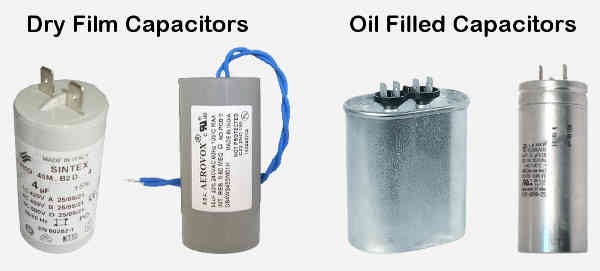

Capsylite
The name used by Osram-Sylvania ® / Osram for their double envelope halogen bulbs which are bulbs that have an outer envelope around the halogen capsule such as PAR bulbs.
Carriage Light
See Fixture (Lighting).
Cartridge
Type of indicator bulb that is contained within what is called a 'cartridge'. They are designed for use in special threaded lampholders used for panel lighting applications.

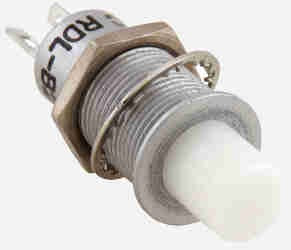
Bulb
Lampholder


CCFL
See Cold Cathode.
Ceiling Mount
See Mounting - Fixture > Ceiling Mount.
CFR
See Code of Federal Regulations.
Chain Mount
See Mounting - Fixture.
Chandelier
A decorative suspended lighting fixture.

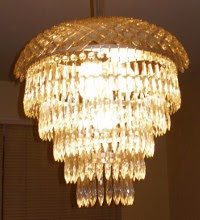
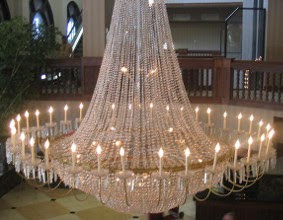



Charge
Measured in Coulombs (abbreviated q or Q). In practice charge is most often discussed in terms of Amp-Hours (Ah). One coulomb is the amount of charge transported by a current of 1 amp over 1 second. That means that 1 amp for 1 hour (1 Amp-Hour) is 3600 coulombs (60 seconds * 60 minutes = 3600).
Chromaticity
- A method of stating the color of a light source by stating the x and y coordinates of the location of the color on the CIE Standard Chromaticity Diagram. In practice it is far more common in the lighting industry to state the color temperature of a light source in Kelvin.
- See Color Temperature.
Circle E
"Designates a ballast meets or exceeds the requirements of Public Law 100-357 establishing standards of efficiency." - Advance Ballast Glossary


Class A/B Application
A FCC classification for electronic devices. Class A is for devices for use in commercial/industrial applications and Class B is for devices for use in residential applications.
Cobrahead Fixture
See Fixture.
Coefficient of Utilization
A value between zero and one that is calculated by dividing the initial lumens that strike the work surface divided by the initial lumens of the bulb being used within. See Luminaire Efficiency.
Coil
"Copper or aluminum wire or a combination of both types wound into a coil. The coils are then slid onto an iron core. It is common for both copper and aluminum wire to be used in the same coil or for either in a single coil or sometimes a combination surrounding core in ballast." - Advance Ballast glossary. See Lamination.
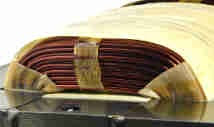

Color
The visual perception of one or more wavelengths of light. When combined these wavelengths stimulate the eye's red, blue and green receptors which then in turn send signals to the brain resulting in the perception of specific colors. Most commonly colors are perceived as a result of light being reflected by a surface which then allows for additional differentiation of physical objects.
Color Blindness
The name "color blindness" is actually misleading as 99% of cases are actually suffering from a color deficiency. Color deficiency/blindness affects 8-10% of males and 0.5% of females. Color Blindness can be the result of a number of different conditions including but not limited to chemical damage, disease, nerve damage and genetic disorders. Color blindness can vary wildly from a complete inability to perceive one or more primary colors to a simple deficiency of one or more primary colors to a combination of the two.
Color Perception
How a color is perceived by the human eye or, depending on the context, an individual when lit by a particular light source.
Color Rendering
This can refer to two different things:
- 1 • The visual perception of an individual as to how they perceive colors lit by a particular light source. This then is obviously relative to the individual and thus potentially different for each person. In this context color rendering can refer to an individual's perception of the accuracy of the colors being rendered and/or simply the pleasantness with which the colors are being rendered.
Example: Red meat is being displayed in a case in a grocery store. Because it has been in the case for some time, it has begun to turn a grayish color. Accurate lighting would show that its color has changed to a less appealing one. However, a light source emitting colors that make the meat appear more pink will result in a more pleasant visual perception. - 2 • The measurement of the light source according to the industry standard known as the Color Rendering Index.
Color Rendering Index
Abbreviated as "CRI". An international standard scale of measurement expressed as a value of 0 to 100. The value expresses the degree to which the visual perception of certain colors being lit by the light source in question matches the visual perception of those same colors when lit by a reference light source of the same color temperature. A reference light source has a CRI of 100.
Color Temperature
- "The absolute temperature of a blackbody radiator having a chromaticity equal to that of the light source." - Illuminating Engineering Society
- In industry speak it is often shortened to "color temp". Color temperature is expressed using the kelvin temperature scale. The concept is based on heating a "black body" radiator to a particular temperature which would result in the radiator emitting a specific color that corresponds to its temperature. It is worth mentioning that a perfect black body radiator doesn't exist but many materials such as tungsten filaments demonstrate the concept very well. Thus a light source whose primary light output comes from a heated tungsten filament will emit light of a predictable color when its filament is heated to a specific temperature. As an example, today's incandescent bulbs emit light by heating their tungsten filaments to temperatures that generally lie between 2200K and 2800K. Note the color of the tips of the cast iron horseshoes in the picture below and to the right. The color of the light being emitted corresponds to the actual temperature of the metal (cast iron actually melts at around 1473K but the point is clear enough). This brings to mind the saying "white hot". The rectangular block in the animated picture below and to the left shows a visual representation of the corresponding color temperature printed below it.
The block shows the color tempRough example of a black body radiator
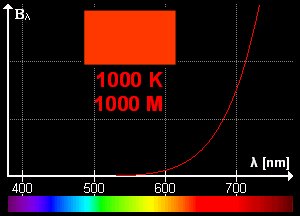
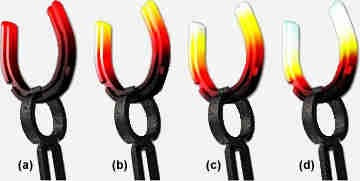
- Correlated Color Temperature
The majority of light sources in use, such as LEDs or fluorescent bulbs, do not use any form of black body radiator to produce light. Regardless however, the colors emitted by a black body radiator are the standard for color measurement. Thus these other light sources must be designed in such a way as to emit a color of light that approximates an intended temperature of a black body radiator. This approximated color temperature emitted by such a bulb is called its Correlated Color Temperature.
Combination Terminals
At one time sealed beam bulbs came with two different bases and thus were treated as two different products. The first variety came with screw terminals while the other variety came with slip-on terminals. The slip-on terminals were considered special and were designated with a -1 at the end of the bulb's description. Eventually the screw and slip-on terminals were combined into one called...combination terminals.
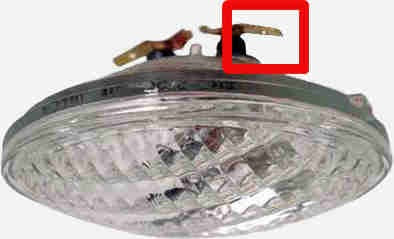
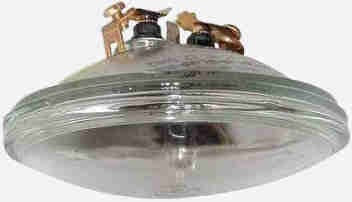
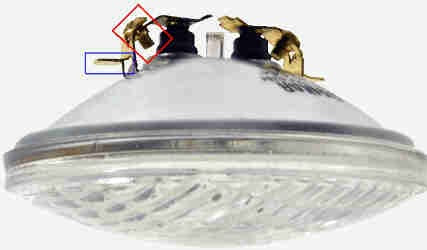
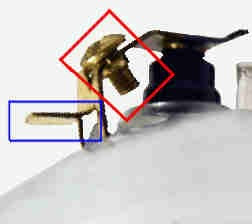
Slip-on Only
Screw Only


Combination Terminals


Commission Internationale de lÉclairage
Commission Internationale de Photométrie
The predecessor to the Commission Internationale de lÉclairage. It was disbanded in 1913. See International Commission on Illumination.
Compact Fluorescent Bulb
- Abbreviated as "CFL". A bulb type based on fluorescent technology designed to be compact, efficient and practical. In order to achieve a smaller footprint the bulb's tube(s) are generally arranged in various shapes such as coils, u-shapes, twin tubes and other shapes. The name "compact fluorescent" is used to refer to all compact fluorescent bulbs including those with and without integrated ballasts. Like traditional fluorescent bulbs, compact fluorescent bulbs require starting circuits and ballasts and similarly are sensitive to abnormally high and low temperatures. See Fluorescent Bulb, Twin Tube.
- "The variation in lamp color at start-up of the lamp is a result of phosphor activation. Phosphor is the coating on the inside of the bulb that glows when the bulb has an electrical charge to give the lamp a 'white' light effect. Different phosphor combinations produce different colors and may have slightly different response times. These differences are why the lamp sometimes looks pink or purple when you start it."
- The first commercially viable CFL was released in 1980 by Philips Lighting as their model "SL". This bulb operated using an integrated magnetic ballast. Osram released the first CFL with an integrated electronic ballast in 1985.
Cone Cell
See Photoreceptor Cell.
Conformal Coating
"Material which surrounds and adheres to components and protects them." - Advance Ballast Glossary.
Cool White
The traditional industry standard name given to the Correlated Color Temperature of 4100 kelvin.
Core
"Component of electromagnetic ballast that is surrounded by the coil. Core is comprised of steel laminations or solid ferrite material." - Advance Ballast glossary. See Laminations.
Core and Coil
- When used in industry conversations it is referring to a High Intensity Discharge magnetic ballast.
- Technically this refers to metal wire wound around an iron core and then used as a low frequency transformer. In the lighting industry it is only used to describe a part of a ballast.
Correlated Color Temperature
Crest Factor
- Abbreviated as C or CF. The ratio of peak current to RMS current. Direct Current (DC) voltages have a crest factor.
C = Peak Amps over RMS Amps - Peak Lamp Current
The maximum current load by a light source during operation. - RMS Lamp Current
This is essentially the average lamp current load.Square Wave = 1.0 C
(always)Sine Wave = 1.414 C
(always)RMS Current 5A, peak
current 21A = 4.2 C
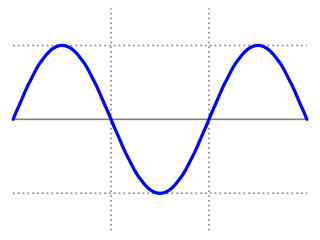
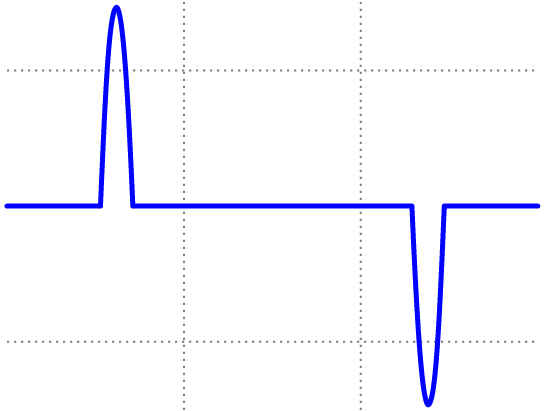
CSA
Current Limiting
A part or parts within an electrical device that work together to control its output. In ballasts such a device is used to supply and control the necessary electrical characteristics such as voltage and current for both bulb starting and normal operation.
Cutoff
A device acting as a "hood" mounted on the outside of a fixture that is designed to block stray unused light that would be considered light pollution.
Cycling
A constant extinguishing and restarting of a bulb. This is caused generally by an older bulb
